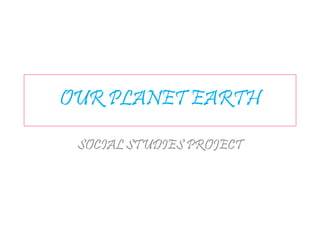
Our Planet Earth-Realms
- 1. OUR PLANET EARTH SOCIAL STUDIES PROJECT
- 2. EARTH Earth sometimes referred to as the "Blue Marble", Terra or "Gaia", is the third- closest planet to the Sun, the densest planet in the Solar System, the largest of the Solar System's four terrestrial planets and the only celestial body known to accommodate life.
- 3. It is home to millions of species, including a global population of humans, that are supported and nourished by its biosphere and minerals. The human population is grouped into around two- hundred independent sovereign states that interact, among other means, through diplomacy, conflict, travel, trade and media.
- 5. REALMS OF THE EARTH The Earth’s Surface Consists Of Both land and water. A blanket of air surrounds the earth. It is inhabited by living organisms, plants and animals. All these elements- land, air, water and living organisms, make up the Constituents or Realms of the Earth.
- 6. There are four realms of the Earth: -Lithosphere -Hydrosphere -Atmosphere -Biosphere
- 8. LITHOSPHERE The lithosphere is the rigid outermost shell of a rocky planet defined on the basis of the mechanical properties. On Earth, it comprises the crust and the portion of the upper mantle that behaves elastically on time scales of thousands of years or greater. The outermost shell of a rocky planet defined on the basis of the chemistry and mineralogy is a crust.
- 10. HYDROSPHERE The hydrosphere in physical geography describes the combined mass of water found on, under, and over the surface of a planet. This includes water in liquid and frozen forms in ground waters, glaciers, oceans, lakes and streams. Salina water account for 97.5% of this amount. Fresh water accounts for only 2.5%. Of this fresh water 68.7% is in the "form of ice and permanent snow cover in the Arctic, the Antarctic, and in the mountainous regions.
- 12. ATMOSPHERE Atmosphere is a layer of gases surrounding a planet or other material body of sufficient mass that is held in place by the gravity of the body. An atmosphere is more likely to be retained if the gravity is high and the atmosphere's temperature is low. Earth's atmosphere, which is mostly nitrogen, also contains oxygen used by most organisms for respiration and carbon dioxide used by plants, algae and cyanobacteria for photosynthesis, also protects living organisms from genetic damage by solar ultraviolet radiation.
- 14. BIOSPHERE The biosphere is the global sum of all ecosystems. It can also be termed the zone of life on Earth, a closed system, and largely self-regulating. By the most, general bio physiological definition, the biosphere is the global ecological system integrating all living beings and their relationships, including their interaction with the elements of the lithosphere, hydrosphere, and atmosphere.
- 16. EARTH’S FORMATION The Earth is made up of three layers: -CRUST -MANTLE -OUTER CORE -INNER CORE
- 18. CRUST The crust is the outermost solid shell of a rocky planet or natural satellite, which is chemically distinct from the underlying mantle. The crusts of Earth, the Moon, Mercury, Venus, Mars, Io, and other planetary bodies have been generated largely by igneous processes, and these crusts are richer inincompatible elements than their respective mantles.
- 20. MANTLE The mantle is a part of a terrestrial planet or other rocky body large enough to have differentiation by density. The interior of Earth, similar to the other terrestrial planets, is chemically divided into layers. The mantle is a layer between the crust and the outer core. Earth's mantle is a silicate rocky shell about 2,900 kilometers (1,800 mi) thick that constitutes about 84% of Earth's volume. It is predominantly solid but in geological time it behaves like very viscous liquid. The mantle encloses the hot core rich in iron and nickel, which occupies about 15% of Earth's volume.
- 22. OUTER CORE Earth's outer core is a liquid layer about 2,266 km (1,408 mi) thick composed of iron and nickel that lies above Earth's solid inner core and below its mantle. Its outer boundary lies 2,890 km (1,800 mi) beneath Earth's surface. The transition between the inner core and outer core is located approximately 5,150 km (3,200 mi) beneath Earth's surface.
- 24. INNER CORE Earth's inner core is Earth's innermost part and is a primarily solid ball with a radius of about 1,220 km (760 mi), according to seismological studies. (This is about 70% of the Moon's radius.) It is believed to consist primarily of an iron–nickel alloy and to be approximately the same temperature as the surface of theSun: approximately 5700 K (5430 °C).
- 26. EARTH’S SURFACE The Earth’s surface is divided into two parts: -WATER -LAND
- 28. WATER Water covers 71% of the Earth's surface. It is vital for all known forms of life. On Earth, 96.5% of the planet's water is found in seas and oceans, 1.7% in groundwater, 1.7% in glaciers and the ice caps of Antarctica and Greenland, a small fraction in other large water bodies, and 0.001% in the air as vapor, clouds (formed of solid and liquid water particles suspended in air), and precipitation. Only 2.5% of the Earth's water is freshwater, and 98.8% of that water is in ice and groundwater. Less than 0.3% of all freshwater is in rivers, lakes, and the atmosphere, and an even smaller amount of the Earth's freshwater (0.003%) is contained within biological bodies and manufactured products.
- 30. LAND Land is the solid surface of the Earth that is not permanently covered by water. The vast majority of human activity occurs in land areas that support agriculture, habitat, and various natural resources. Some life forms including terrestrial plants and terrestrial animals have developed from predecessor species that lived in bodies of water to exist on land.
- 32. DONE BY : NABA NAUSHAD KHAN
